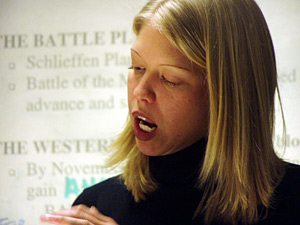|
Audio
Photos
|
March 21, 2005
 |
| Champlin Park High School teacher Heather Berge talked about World War I with her Advanced Placement students. (MPR Photo/Tim Pugmire) |
St. Paul, Minn. — For some high school students, the approach of graduation is a chance to ease up on their efforts in the classroom. Gov. Pawlenty says those students are wasting time when they should be preparing for the future. He stressed the point earlier this year in his State of the State Address.
"Too many of our 11th- and 12th-graders have academically 'checked out,'" Pawlenty said. "Our 'Get Ready, Get Credit'" initiative will give them and their parents a powerful incentive to check back in."
Pawlenty wants to give every Minnesota high school student the chance to earn college credits without leaving their school building. Students can gain those credits now through the state's Post-Secondary Enrollment Options Program, but they can only do it by spending part of their school day on a college campus.
Under the governor's proposal, students would take college-level courses in their high schools and acquire the college credits by passing exams. His budget includes $5 million to cover testing fees and teacher incentives.
Pawlenty's education commissioner, Alice Seagren, said most high school students could be taking rigorous courses now. But she said too many choose easy classes instead.
"It's silly for us as taxpayers to be paying for kids to be in 12th grade and they're not taking any course work," Seagren said. "So, that's one of the reasons behind it, to really encourage kids to take more course and to get credit, which is great for families as far as the economics of it goes."
The students in an Advanced Placement class at Champlin Park High School had not "checked out" on their school work. They were alert and engaged as they studied college-level European history. Teacher Heather Berge led a discussion on the World War I.
Nationwide, more than 14,000 high schools offer courses on dozens of subjects through the AP program. At the end of the year, students can take an $80 test. If they pass, they get college credit. Students can save money on their college expenses. They also get a feel for the workload ahead of them.
Berge said more students could take advantage of the opportunity.
"It's the writing, it's the reading, it's primary sources and analyzing historical documents, making connections," Berge said. "And a lot more kids could do it and could benefit from it if they pushed themselves, if their parents pushed. I think there's a lot more here that need it and could do it."
A student like Robert Mohr didn't need convincing.
"I'm still working hard senior year just because I want to, like as long as I'm here I might as well learn things," Mohr said.
Mohr is a Champlin Park senior who thrives on academic challenges. His solid 4.0 grade point average was built on mostly AP and Honors courses. Mohr also took college-level English and Economics classes this year through a program with the University of Minnesota.
"I get bored pretty easily in like less challenging classes," Mohr said. "And so for me it would actually be not too fun to just slide out of senior year. Because I'd be pretty bored everyday."
Mohr is among the state's top students. He was named a National Merit Scholarship semifinalist. A student like Amanda Booth might be more typical. Booth is a college-bound senior who's balancing academics with a lot of other activities.
"I took a lot of electives, the harder electives, my freshman and sophomore year, so there weren't really a lot left to take," Booth said. "But with volleyball and everything else that I'm involved in it's hard to be in AP classes and then have school and sports and still try to have a social life after that."
High school counselors say Amanda's balancing act is common and a big reason more students aren't taking AP or other tough classes. Last year, just 16 percent of Minnesota's graduating public high school seniors had taken an AP exam. The Pawlenty plan, if approved by the Legislature, seeks an unspecified boost in that number.





